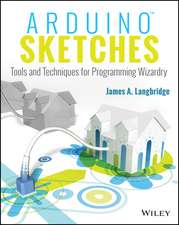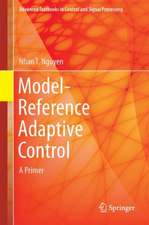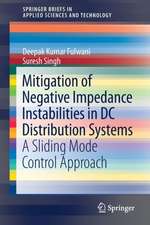Distributed Consensus in Multi-vehicle Cooperative Control: Theory and Applications: Communications and Control Engineering
Autor Wei Ren, Randal Bearden Limba Engleză Hardback – 26 oct 2007
The monograph covers introductory, theoretical and experimental material, featuring - an overview of the use of consensus algorithms in cooperative control; - consensus algorithms in single- and double-integrator, and rigid-body-attitude dynamics; - rendezvous and axial alignment, formation control, deep-space formation flying, fire monitoring and surveillance.
Six appendices cover material drawn from graph, matrix, linear and nonlinear systems theories.
| Toate formatele și edițiile | Preț | Express |
|---|---|---|
| Paperback (1) | 1109.78 lei 43-57 zile | |
| SPRINGER LONDON – 19 oct 2010 | 1109.78 lei 43-57 zile | |
| Hardback (1) | 1117.03 lei 43-57 zile | |
| SPRINGER LONDON – 26 oct 2007 | 1117.03 lei 43-57 zile |
Din seria Communications and Control Engineering
- 18%
 Preț: 953.65 lei
Preț: 953.65 lei - 18%
 Preț: 953.65 lei
Preț: 953.65 lei - 18%
 Preț: 1128.08 lei
Preț: 1128.08 lei - 20%
 Preț: 879.71 lei
Preț: 879.71 lei - 18%
 Preț: 1117.03 lei
Preț: 1117.03 lei - 15%
 Preț: 659.70 lei
Preț: 659.70 lei - 15%
 Preț: 656.89 lei
Preț: 656.89 lei - 18%
 Preț: 896.52 lei
Preț: 896.52 lei - 18%
 Preț: 1113.26 lei
Preț: 1113.26 lei - 18%
 Preț: 1388.22 lei
Preț: 1388.22 lei - 15%
 Preț: 647.27 lei
Preț: 647.27 lei - 18%
 Preț: 954.45 lei
Preț: 954.45 lei - 18%
 Preț: 1231.47 lei
Preț: 1231.47 lei - 18%
 Preț: 948.92 lei
Preț: 948.92 lei - 18%
 Preț: 1232.57 lei
Preț: 1232.57 lei - 15%
 Preț: 643.34 lei
Preț: 643.34 lei - 18%
 Preț: 1127.28 lei
Preț: 1127.28 lei - 18%
 Preț: 1401.30 lei
Preț: 1401.30 lei - 15%
 Preț: 651.51 lei
Preț: 651.51 lei - 20%
 Preț: 1454.07 lei
Preț: 1454.07 lei - 18%
 Preț: 948.79 lei
Preț: 948.79 lei - 18%
 Preț: 1233.06 lei
Preț: 1233.06 lei - 18%
 Preț: 947.85 lei
Preț: 947.85 lei - 18%
 Preț: 950.96 lei
Preț: 950.96 lei - 18%
 Preț: 956.99 lei
Preț: 956.99 lei - 15%
 Preț: 644.18 lei
Preț: 644.18 lei - 18%
 Preț: 946.87 lei
Preț: 946.87 lei - 18%
 Preț: 951.14 lei
Preț: 951.14 lei - 18%
 Preț: 961.55 lei
Preț: 961.55 lei - 15%
 Preț: 644.18 lei
Preț: 644.18 lei - 20%
 Preț: 990.80 lei
Preț: 990.80 lei - 18%
 Preț: 1006.72 lei
Preț: 1006.72 lei - 18%
 Preț: 942.44 lei
Preț: 942.44 lei - 18%
 Preț: 1233.06 lei
Preț: 1233.06 lei - 15%
 Preț: 641.85 lei
Preț: 641.85 lei - 18%
 Preț: 957.75 lei
Preț: 957.75 lei - 15%
 Preț: 649.87 lei
Preț: 649.87 lei - 18%
 Preț: 958.07 lei
Preț: 958.07 lei - 18%
 Preț: 1117.99 lei
Preț: 1117.99 lei - 18%
 Preț: 1395.94 lei
Preț: 1395.94 lei - 18%
 Preț: 781.62 lei
Preț: 781.62 lei - 18%
 Preț: 953.20 lei
Preț: 953.20 lei - 18%
 Preț: 1109.78 lei
Preț: 1109.78 lei - 18%
 Preț: 947.35 lei
Preț: 947.35 lei
Preț: 1117.03 lei
Preț vechi: 1362.23 lei
-18% Nou
Puncte Express: 1676
Preț estimativ în valută:
213.75€ • 223.73$ • 177.90£
213.75€ • 223.73$ • 177.90£
Carte tipărită la comandă
Livrare economică 31 martie-14 aprilie
Preluare comenzi: 021 569.72.76
Specificații
ISBN-13: 9781848000148
ISBN-10: 1848000146
Pagini: 336
Ilustrații: XV, 319 p. With online files/update.
Dimensiuni: 155 x 235 x 24 mm
Greutate: 0.68 kg
Ediția:2008
Editura: SPRINGER LONDON
Colecția Springer
Seria Communications and Control Engineering
Locul publicării:London, United Kingdom
ISBN-10: 1848000146
Pagini: 336
Ilustrații: XV, 319 p. With online files/update.
Dimensiuni: 155 x 235 x 24 mm
Greutate: 0.68 kg
Ediția:2008
Editura: SPRINGER LONDON
Colecția Springer
Seria Communications and Control Engineering
Locul publicării:London, United Kingdom
Public țintă
ResearchCuprins
Overview of Consensus Algorithms in Cooperative Control.- Overview of Consensus Algorithms in Cooperative Control.- Consensus Algorithms for Single-integrator Dynamics.- Consensus Algorithms for Single-integrator Dynamics.- Consensus Tracking with a Reference State.- Consensus Algorithms for Double-integrator Dynamics.- Consensus Algorithms for Double-integrator Dynamics.- Extensions to a Reference Model.- Consensus Algorithms for Rigid Body Attitude Dynamics.- Consensus Algorithms for Rigid Body Attitude Dynamics.- Relative Attitude Maintenance and Reference Attitude Tracking.- Consensus-based Design Methodologies for Distributed Multivehicle Cooperative Control.- Consensus-based Design Methodologies for Distributed Multivehicle Cooperative Control.- Applications to Multivehicle Cooperative Control.- Rendezvous and Axial Alignment with Multiple Wheeled Mobile Robots.- Distributed Formation Control of Multiple Wheeled Mobile Robots with a Virtual Leader.- Decentralized Behavioral Approach to Wheeled Mobile Robot Formation Maneuvers.- Deep Space Spacecraft Formation Flying.- Cooperative Fire Monitoring with Multiple UAVs.- Cooperative Surveillance with Multiple UAVs.
Recenzii
From the reviews:
“This book gives a systematic analysis of distributed consensus problems of multivehicle cooperative control and summarizes the main recent work of the authors. The book is well written, and all of the main theoretical results are given together with rigorous mathematical proofs. This book can be a very useful reference for Ph.D. students and researchers in automatic control.” (Jinhuan Wang and Xiaoming Hu, IEEE Control Systems Magazine, Vol. 30, June, 2010)
“This book gives a systematic analysis of distributed consensus problems of multivehicle cooperative control and summarizes the main recent work of the authors. The book is well written, and all of the main theoretical results are given together with rigorous mathematical proofs. This book can be a very useful reference for Ph.D. students and researchers in automatic control.” (Jinhuan Wang and Xiaoming Hu, IEEE Control Systems Magazine, Vol. 30, June, 2010)
Notă biografică
Wei Ren is an assistant professor in the Department of Electrical and Computer Engineering at Utah State University. He received his Ph.D. degree in electrical engineering from Brigham Young University, Provo, UT, in 2004. From October 2004 to July 2005, he was a research associate in the Department of Aerospace Engineering at the University of Maryland, College Park, MD. His research has been focusing on cooperative control for multiple autonmous vehicles and autonomous control of robotic vehicles. He is a member of the IEEE Control Systems Society and AIAA.
Randal W. Beard received the B.S. degree in electrical engineering from the University of Utah, Salt Lake City in 1991, the M.S. degree in electrical engineering in 1993, the M.S. degree in mathematics in 1994, and the Ph.D. degree in electrical engineering in 1995, all from Rensselaer Polytechnic Institute, Troy, NY. Since 1996, he has been with the Electrical and Computer Engineering Department at Brigham Young University, Provo, UT, where he is currently an associate professor. In 1997 and 1998, he was a Summer Faculty Fellow at the Jet Propulsion Laboratory, California Institute of Technology, Pasadena, CA. In 2006 and 2007 he was a visiting research fellow at the Air Force Research Laboratory, Munitions Directorate, Eglin AFB, FL. His primary research focus is autonomous control of miniature air vehicles and multivehicle coordination and control. He is currently an associate editor for the IEEE Control Systems Magazine and the Journal of Intelligent and Robotic Systems.
Randal W. Beard received the B.S. degree in electrical engineering from the University of Utah, Salt Lake City in 1991, the M.S. degree in electrical engineering in 1993, the M.S. degree in mathematics in 1994, and the Ph.D. degree in electrical engineering in 1995, all from Rensselaer Polytechnic Institute, Troy, NY. Since 1996, he has been with the Electrical and Computer Engineering Department at Brigham Young University, Provo, UT, where he is currently an associate professor. In 1997 and 1998, he was a Summer Faculty Fellow at the Jet Propulsion Laboratory, California Institute of Technology, Pasadena, CA. In 2006 and 2007 he was a visiting research fellow at the Air Force Research Laboratory, Munitions Directorate, Eglin AFB, FL. His primary research focus is autonomous control of miniature air vehicles and multivehicle coordination and control. He is currently an associate editor for the IEEE Control Systems Magazine and the Journal of Intelligent and Robotic Systems.
Textul de pe ultima copertă
The coordinated use of autonomous vehicles has an abundance of potential applications from the domestic to the hazardously toxic. Frequently the communications necessary for the productive interplay of such vehicles may be subject to limitations in range, bandwidth, noise and other causes of unreliability.
Information consensus guarantees that vehicles sharing information over a network topology have a consistent view of information critical to the coordination task. Assuming only neighbor-neighbor interaction between vehicles, Distributed Consensus in Multi-vehicle Cooperative Control develops distributed consensus strategies designed to ensure that the information states of all vehicles in a network converge to a common value. This approach strengthens the team, minimizing power consumption and the deleterious effects of range and other restrictions.
The monograph is divided into six parts covering introductory, theoretical and experimental material and featuring:
• an overview of the use of consensus algorithms in cooperative control;
• consensus algorithms in single- and double-integrator dynamical systems;
• consensus algorithms for rigid-body attitude dynamics;
• rendezvous and axial alignment, formation control, deep-space formation flying, fire monitoring and surveillance.
Notation drawn from graph and matrix theory and background material on linear and nonlinear system theory are enumerated in six appendices. The authors maintain a website at which can be found a sample simulation and experimental video material associated with experiments in several chapters of this book.
Academic control systems researchers and their counterparts in government laboratories and robotics- and aerospace-related industries will find the ideas presented in Distributed Consensus in Multi-vehicle Cooperative Control of great interest. This text will also serve as a valuable support and referencefor graduate courses in robotics, and linear and nonlinear control systems.
Information consensus guarantees that vehicles sharing information over a network topology have a consistent view of information critical to the coordination task. Assuming only neighbor-neighbor interaction between vehicles, Distributed Consensus in Multi-vehicle Cooperative Control develops distributed consensus strategies designed to ensure that the information states of all vehicles in a network converge to a common value. This approach strengthens the team, minimizing power consumption and the deleterious effects of range and other restrictions.
The monograph is divided into six parts covering introductory, theoretical and experimental material and featuring:
• an overview of the use of consensus algorithms in cooperative control;
• consensus algorithms in single- and double-integrator dynamical systems;
• consensus algorithms for rigid-body attitude dynamics;
• rendezvous and axial alignment, formation control, deep-space formation flying, fire monitoring and surveillance.
Notation drawn from graph and matrix theory and background material on linear and nonlinear system theory are enumerated in six appendices. The authors maintain a website at which can be found a sample simulation and experimental video material associated with experiments in several chapters of this book.
Academic control systems researchers and their counterparts in government laboratories and robotics- and aerospace-related industries will find the ideas presented in Distributed Consensus in Multi-vehicle Cooperative Control of great interest. This text will also serve as a valuable support and referencefor graduate courses in robotics, and linear and nonlinear control systems.
Caracteristici
Lays out the theoretical principles of co-ordinated control together with their experimental application Shows the reader how to deal with groups of autonomous vehicles in aerial, terrestrial and submarine environments Provides the tools to overcome impaired communication using constantly up-dated neighbor-neighbor interchange Includes supplementary material: sn.pub/extras


















